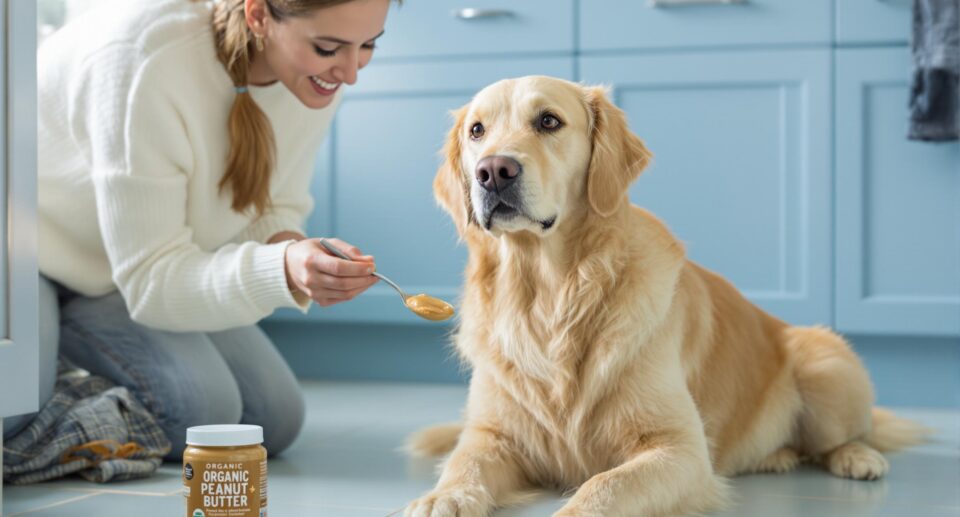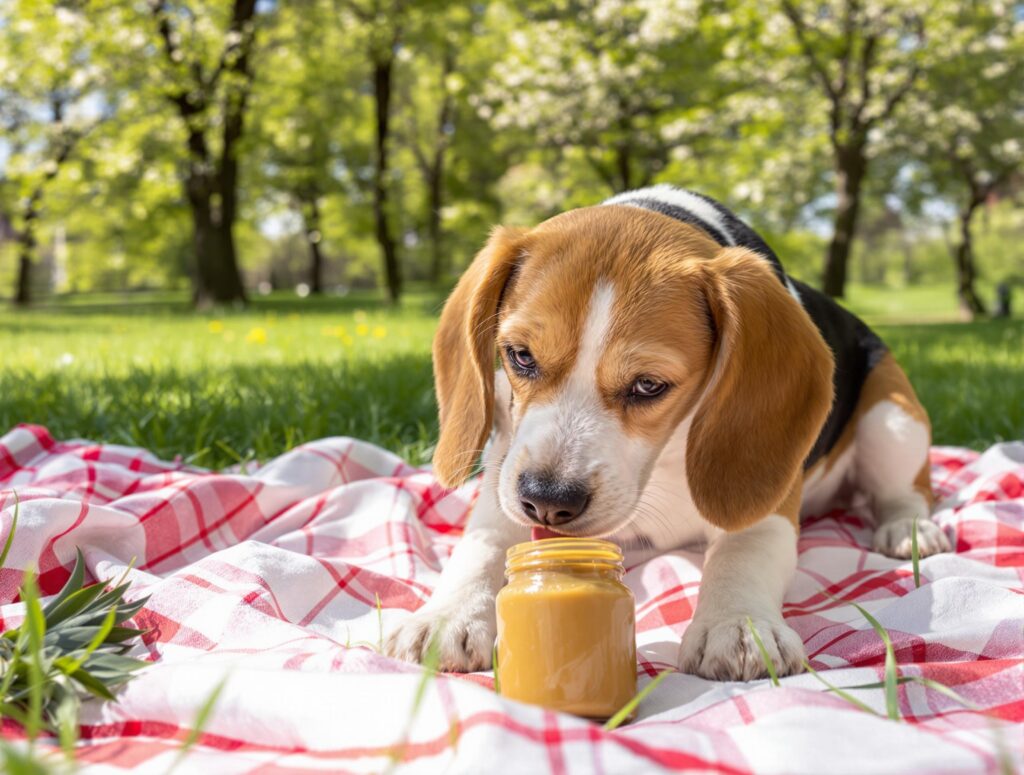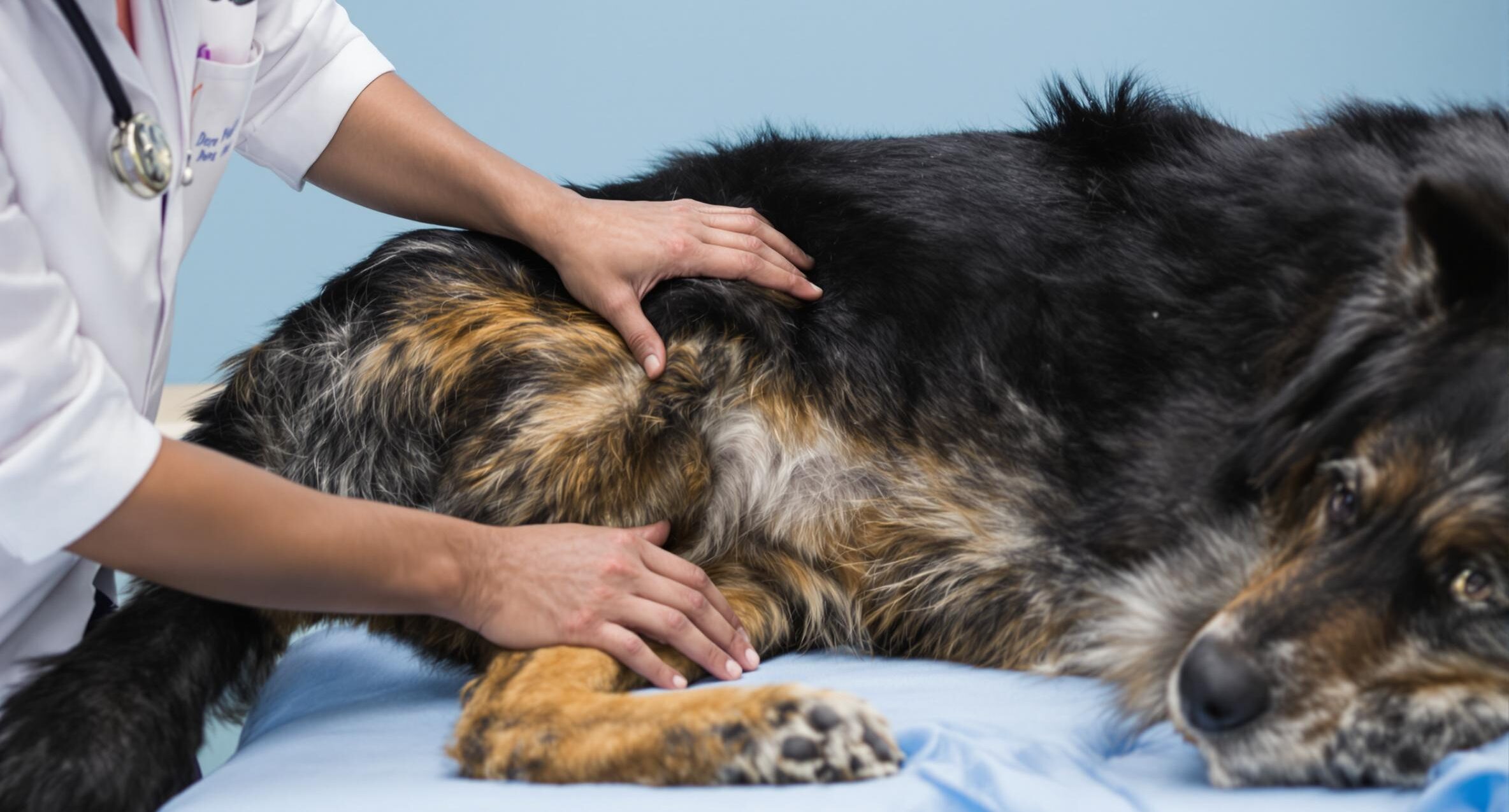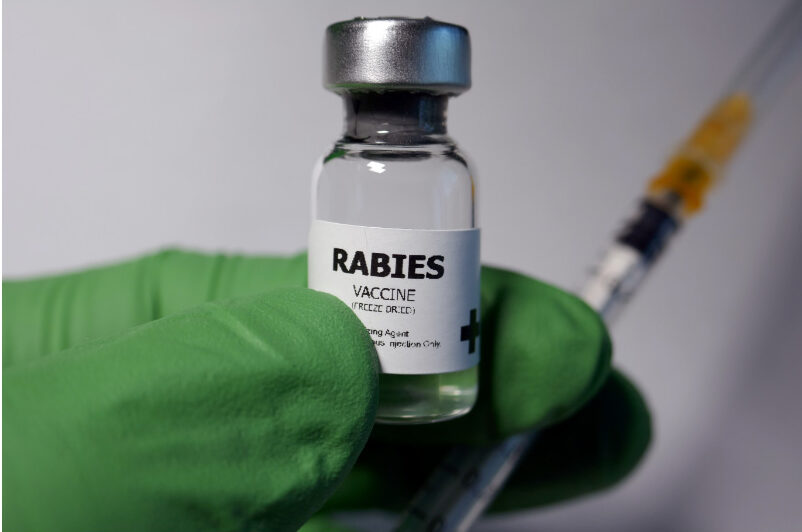Can Dogs Eat Peanuts and Peanut Butter?

Key takeaways:
- Peanuts and most peanut butter varieties are generally safe for dogs when served in moderation and with the proper precautions.
- Avoid any peanut butter containing xylitol, an artificial sweetener highly toxic to dogs.
- Peanut butter should not exceed 10 percent of your dog’s daily calories to help avoid health problems.
If you’ve ever opened a jar of peanut butter near your dog, you’ve likely seen just how eager they can be to get a taste. Peanut butter is a go-to treat for many pet owners, whether hiding a pill, filling a toy, or rewarding your dog with something tasty. Plain peanuts can also be used for training or as occasional snacks.
However, not all peanuts or peanut butter products are created equal. Knowing which types are safe, how much to give, and how to serve them can help you confidently treat your dog.
PetHealthMD provides trusted advice to help you know your peanut and peanut butter options so you can make an informed choice with your vet. Here’s what to keep in mind.
Can dogs eat peanuts and peanut butter?
In general, yes—dogs can safely enjoy peanuts and peanut butter when you take proper precautions. These treats can add variety to your dog’s diet and provide beneficial nutrients. However, there are significant risks to avoid, especially regarding product selection and portion size.
Nutritional benefits of peanuts and peanut butter
Peanuts and peanut butter are nutrient-dense and can provide benefits when given appropriately:
- Protein: Helps maintain muscle mass and supports energy.
- Healthy fats: Promote skin and coat health.
- Vitamins and minerals: Including B vitamins (such as niacin), vitamin E, magnesium, and phosphorus, all of which contribute to metabolic function, nerve health, and bone strength.
However, these benefits come with calories. Peanut butter is calorie-dense, so keeping portions small is key.
Safe ways to feed peanuts and peanut butter to dogs
Peanuts and peanut butter can be healthy occasional treats, but selecting the right products and avoiding common hazards is key. Here’s what you need to know:
Safe choices
- Plain peanuts: Unsalted, raw, or dry-roasted peanuts are best.
- Natural peanut butter: Choose varieties with only peanuts—or peanuts and a small amount of salt—as ingredients.
What to avoid
- Xylitol: This artificial sweetener is highly toxic to dogs and is often found in sugar-free or reduced-sugar peanut butter. Always read labels carefully.
- Chocolate: Chocolate-flavored peanut butter contains theobromine and caffeine, both harmful to dogs.
- Added salt or sugar: Too much salt can contribute to heart issues and dehydration; added sugar increases the risk of obesity and diabetes.
- Peanut shells: Tough to digest and can cause choking or intestinal blockages.
- Flavored peanuts: Often contain seasonings or additives that can upset your dog’s stomach or pose health risks.
Watch for these risks, even with safe products
- High fat content: Peanut butter is calorie-dense and high in fat. Feeding too much can lead to weight gain or trigger pancreatitis, a serious condition requiring veterinary care.
- Choking hazards: Whole peanuts can pose a choking risk, especially for small dogs or dogs that gulp their food.
By choosing safe products and serving them in moderation, you can help your dog enjoy these treats without unnecessary risks.
Signs of peanut allergies in dogs
Peanut allergies in dogs are uncommon, but they can occur. Like with any new food, it is essential to introduce peanuts or peanut butter gradually and observe your dog closely. Allergic reactions may appear within minutes to several hours after eating a new treat.
Watch for the following signs of a possible allergic reaction:
- Facial swelling: Look for swelling around the muzzle, eyes, or ears.
- Itching or scratching: Excessive licking, scratching, or chewing at the skin.
- Skin changes: Hives, red patches, or rash-like bumps.
- Digestive upset: Vomiting, diarrhea, or signs of stomach discomfort.
- Behavioral changes: Restlessness, anxiety, or signs of distress.
If you notice these symptoms, stop feeding peanuts or peanut butter immediately and contact your veterinarian. They can help determine whether your furry friend has a food allergy and advise you on safe treat options.
How much peanut butter can you give your dog?
The safest way to add peanut butter to your dog’s diet is to offer it sparingly as a treat, not a staple. Here are some general guidelines by size:
- Toy breeds: ¼ teaspoon per serving
- Small dogs: Up to ½ teaspoon per serving
- Medium dogs: Up to 1 teaspoon per serving
- Large dogs: Up to 1 tablespoon per serving
Feeding frequency
Limit peanut butter treats to no more than twice daily. Ensure that all treats combined (including peanut butter) make up no more than 10% of your dog’s total daily caloric intake.
It’s always best to check with your veterinarian to fine-tune treat amounts for your dog’s specific needs and health status.
The best ways to serve peanut butter

Peanut butter is a versatile treat you can use together with your dog’s daily activities to add enjoyment and positive reinforcement. Here are some of the best ways to incorporate it in your dog’s diet:
- Training: A small lick of peanut butter makes an excellent high-value reward during training sessions. Because most dogs love the taste, it can help reinforce new behaviors and commands more effectively than lower-value treats.
- Medication: Hiding pills in a dollop of peanut butter can make medication time much easier. The rich texture and flavor can mask the taste of pills and encourage dogs to swallow them willingly. Always check with your veterinarian first to confirm that peanut butter is appropriate for your dog’s specific medication.
- Enrichment: Peanut butter is ideal for filling treat-dispensing toys or puzzle feeders. Spreading a small amount inside a toy or similar product can provide long-lasting mental stimulation and help reduce boredom. For an extra challenge, freeze the toy after filling it, making the experience even more engaging for your dog.
- Bonding: Sharing a special spoonful of peanut butter during a calm moment can help strengthen your bond with your dog. Whether it’s a reward after a grooming session, a treat during cuddle time, or a way to help a nervous dog feel more comfortable, this small act of sharing can build trust and positive associations.
By using peanut butter creatively and in moderation, you can enhance your dog’s routine and create more opportunities for connection and enrichment.
Frequently asked questions about dogs and peanuts
Can puppies eat peanuts or peanut butter?
Puppies can have small amounts of plain peanuts or peanut butter occasionally, but their digestive systems are more sensitive than those of adult dogs. Consult your veterinarian before introducing peanut-based treats to puppies, and avoid feeding fatty treats in excess during this important growth phase.
What if my dog eats peanut butter with xylitol?
If your dog consumes any peanut butter containing xylitol, seek emergency veterinary care immediately. Do not wait for symptoms to appear—xylitol poisoning can cause a rapid drop in blood sugar, seizures, liver failure, or even death.
How can I be sure peanut butter is xylitol-free?
Read ingredient labels carefully. Look for terms such as xylitol or birch sugar. When in doubt, contact the manufacturer. Choosing peanut butter explicitly made for dogs can offer peace of mind.
Is crunchy peanut butter safe for dogs?
In moderation, crunchy peanut butter is fine for dogs that chew slowly and thoroughly. However, if your dog eats quickly or has dental issues, creamy peanut butter is safer.
Are other nuts safe for dogs?
Many nuts are unsafe for dogs. Macadamia nuts, walnuts, and pecans are toxic and should never be fed. Stick to peanuts, and always serve them in moderation. When unsure, ask your veterinarian before introducing any new nuts.
Supporting your dog’s health with informed choices
Offering peanuts and peanut butter can be a fun way to treat your dog when done thoughtfully. Choosing safe products and sticking to proper portion sizes can help prevent problems and support your dog’s well-being.
If you notice any changes in your dog’s digestion, appetite, or behavior after introducing new treats, contact your veterinarian. They can help you adjust treatment choices or suggest healthier alternatives based on your dog’s nutritional needs.
You do not have to navigate these choices alone. 1800PetMeds makes supporting your dog’s health easier with a wide selection of high-quality dog food, treats, and supplies you can use together with your dog’s daily meals.





